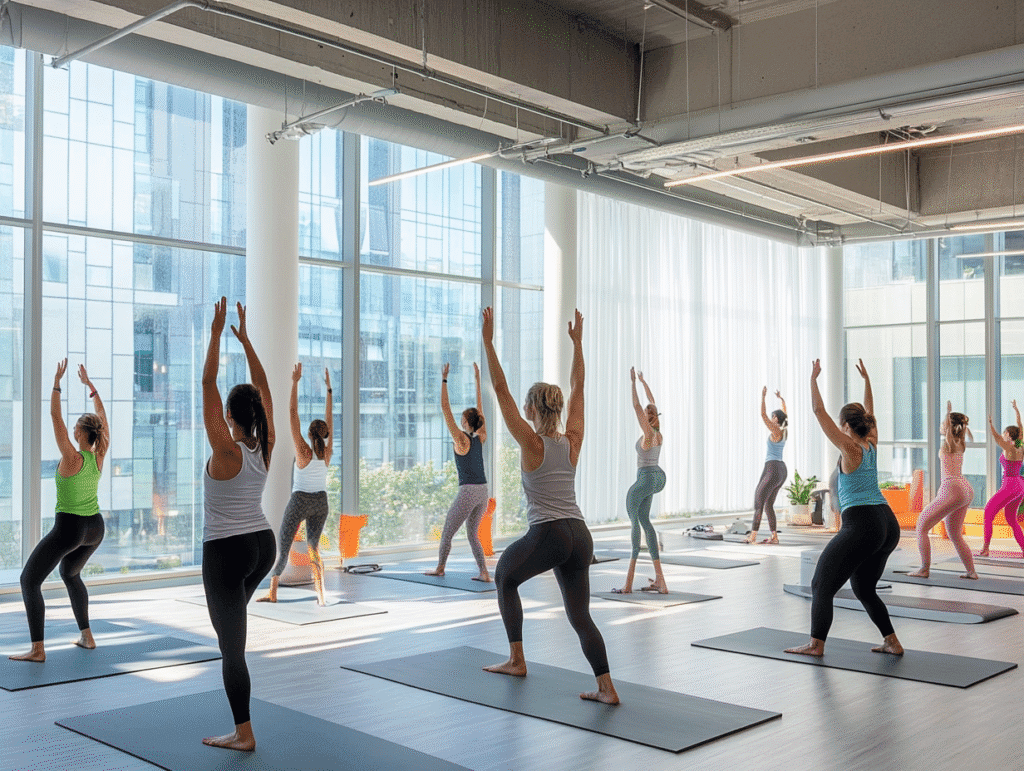
Understanding Stretch Fabrics
What Is Stretch Fabric?
Definition:
Stretch fabric is a textile engineered to expand and recover, providing elasticity beyond natural fiber limitations. It combines rigid fibers (like polyester or nylon) with elastic components (such as spandex) to achieve flexibility without losing shape.
Common Uses:
- Activewear: Leggings, sports bras, and running shorts rely on stretch for unrestricted movement.
- Athleisure: Stretch jeans, hoodies, and T-shirts blend comfort with style.
- Swimwear: Stretch allows snug yet flexible fits for swimsuits and rash guards.
- Underwear & Shapewear: Elasticity ensures comfort and contouring.
Key Materials:
- Spandex/Elastane/Lycra®: Synthetic fibers offering 5–8x stretch (Lycra is a branded version).
- Blends: Cotton-spandex (softness + stretch), polyester-elastane (durability + flexibility).
- Innovations: Recycled stretch fabrics (e.g., ECONYL® with elastane) for sustainability.
Why Stretch Matters
Benefits:
- Comfort:
- Conforms to body shapes, reducing friction (e.g., no stiff seams in yoga pants).
- Breathable blends wick sweat during workouts.
- Flexibility:
- Enables dynamic movements (e.g., squat-proof leggings with 4-way stretch).
- Critical for dancewear, gymnastics, and cycling apparel.
- Fit & Shape Retention:
- Stretch fabrics resist sagging or bagging (unlike pure cotton).
- Compression fabrics improve muscle support and circulation.
- Performance Enhancement:
- Reduces wind resistance in athletic gear (e.g., speedskating suits).
- UV-protective stretch fabrics for outdoor sports.
Industries Relying on Stretch Fabrics:
- Fashion: Stretch denim (“jeggings”), bodycon dresses.
- Sportswear: Nike Dri-FIT, Lululemon’s Luon® fabric.
- Medical: Compression socks for circulation, elastic bandages.
- Automotive: Stretchable seat covers for durability.
Key Takeaways for This Section:
- Stretch fabrics are purpose-built for movement, combining elasticity with durability.
- Material blends dictate performance (e.g., spandex for stretch, nylon for abrasion resistance).
- From runway fashion to medical rehab, stretch technology meets diverse needs.
2-Way vs. 4-Way Stretch Explained
What Is 2-Way Stretch?
Definition:
2-way stretch fabric expands and retracts along a single axis—either horizontally (widthwise) or vertically (lengthwise). It provides flexibility in one direction while maintaining stability in the other.
How It Works:
- The fabric contains elastic fibers (like spandex) woven or knitted in one direction, allowing stretch along that plane.
- Often used in garments where controlled flexibility is needed without excessive looseness.
Examples:
- Waistbands: Stretchy denim jeans or leggings that expand at the waist but keep their shape elsewhere.
- T-Shirts & Casual Wear: Cotton-spandex blends that offer slight stretch for comfort but retain structure.
- Swimwear (Some Types): One-piece swimsuits with side panels that stretch horizontally for better fit.
Pros:
✔ More Structured Fit – Less likely to sag or overstretch in unwanted areas.
✔ Cost-Effective – Often cheaper to produce than 4-way stretch fabrics.
✔ Durability – Less prone to pilling or warping because of limited stretch.
Cons:
✖ Limited Mobility – Not ideal for high-intensity activities requiring multi-directional movement.
✖ Potential Fit Issues – May feel restrictive if the stretch direction doesn’t align with body movement.
What Is 4-Way Stretch?
Definition:
4-way stretch fabric expands and recovers in both lengthwise (vertical) and widthwise (horizontal) directions, offering full freedom of movement.
How It Works:
- Elastic fibers are woven or knitted in a multi-directional pattern, allowing the fabric to stretch in all directions.
- Often combined with moisture-wicking and breathable properties for performance wear.
Examples:
- High-Performance Activewear: Yoga pants, running tights, and compression shorts that move with the body.
- Athletic Jerseys & Sportswear: Basketball shorts, cycling jerseys that need to stretch in all planes.
- Medical & Compression Garments: Knee braces, compression sleeves that require snug, adaptive fit.
Pros:
✔ Superior Flexibility – Allows full range of motion, ideal for sports and dynamic activities.
✔ Better Shape Retention – Recovers quickly after stretching, reducing sagging.
✔ Enhanced Comfort – Moves naturally with the body, reducing friction and irritation.
Cons:
✖ Higher Cost – More complex manufacturing increases price.
✖ Potential Overstretching – If not properly constructed, may lose shape over time.
✖ Less Structure – May not provide enough support for certain garments (e.g., structured blazers).
Key Takeaways for This Section:
4-way for high-intensity activities (yoga, running, compression wear).
2-Way Stretch = Single-direction flexibility (good for structured, casual wear).
4-Way Stretch = Omni-directional movement (best for activewear and performance gear).
Choose based on use:
2-way for everyday comfort (jeans, basic tees).
Key Differences Between 2-Way and 4-Way Stretch
Direction of Stretch
2-Way Stretch:
- Stretches along one axis only (either horizontally or vertically).
- Movement is linear—fabric expands in one direction while staying stable in the other.
- Example: A T-shirt with slight horizontal stretch for comfort but minimal vertical give.
4-Way Stretch:
- Stretches both horizontally and vertically (and often diagonally).
- Movement is omni-directional, allowing fabric to contour and move with the body in all planes.
- Example: Yoga pants that stretch in every direction during bends, twists, and stretches.
Why It Matters:
- 2-way is better for garments needing targeted flexibility (like a waistband that only needs to expand outward).
- 4-way is essential for full-body motion (like a gymnast’s leotard that must stretch in all directions).
Flexibility & Movement
2-Way Stretch:
- Moderate flexibility—suited for controlled movements.
- Fit: Snug but may restrict complex motions (e.g., squatting in 2-way stretch jeans).
- Best for:
- Casual wear (T-shirts, skirts).
- Light activity (walking, lounging).
4-Way Stretch:
- Maximum flexibility—moves seamlessly with the body.
- Fit: Adaptive and form-fitting without constriction.
- Best for:
- High-intensity workouts (running, cycling, yoga).
- Compression wear (needs to stretch and recoil repeatedly).
Performance Comparison:
| Feature | 2-Way Stretch | 4-Way Stretch |
|---|---|---|
| Range of Motion | Limited to one direction | Full 360° movement |
| Muscle Support | Minimal | Enhanced (hugs the body) |
| Activity Level | Low to moderate | Moderate to high intensity |
Durability & Use Cases
Durability:
- 2-Way Stretch:
- More resistant to overstretching (due to limited elasticity).
- Holds shape longer for structured garments (e.g., blazers, tailored pants).
- 4-Way Stretch:
- Prone to faster wear if stretched excessively (e.g., high-impact sports).
- Requires high-quality blends (e.g., nylon-spandex) for longevity.
Best Use Cases:
| Application | Recommended Stretch Type | Reason |
|---|---|---|
| Everyday Clothing | 2-Way | Balances comfort and structure |
| Athletic Wear | 4-Way | Supports dynamic movement |
| Shapewear | 4-Way | Needs to flex in all directions |
| Denim | 2-Way (with 4-way panels) | Waist stretch + slight mobility |
Pro Tip:
- For longevity, look for reinforced stitching in 4-way stretch garments.
- For casual wear, 2-way stretch fabrics (like cotton-elastane) offer durability without sacrificing comfort.
Key Takeaways:
- Direction: 2-way = single-axis; 4-way = multi-axis.
- Flexibility: 2-way for simplicity; 4-way for advanced mobility.
- Durability: 2-way lasts longer in structured fits; 4-way excels in performance wear.
Choosing the Right Stretch for Your Needs
When to Use 2-Way Stretch
2-way stretch fabrics are ideal for applications where targeted flexibility and structure are more important than full-range movement.
Best Uses:
✔ Everyday Casual Wear
- T-shirts & Polo Shirts: Light horizontal stretch for comfort without losing shape.
- Jeans & Chinos: Waistbands with 2-way stretch prevent gaping while maintaining structure.
- Dresses & Skirts: Bodycon styles that need slight give but retain their silhouette.
✔ Structured Garments
- Blazers & Jackets: Shoulder and sleeve areas with minimal stretch for a polished look.
- Workwear Pants: Office trousers that offer seated comfort but keep a professional drape.
- Swim Cover-Ups: Light stretch for easy wear without excessive cling.
Why Choose 2-Way?
- Provides just enough stretch for comfort while maintaining fabric integrity.
- More cost-effective than 4-way stretch for basic apparel.
- Better for tailored fits where overstretching would ruin the garment’s lines.
When to Use 4-Way Stretch
4-way stretch is the gold standard for any application demanding complete freedom of movement and adaptive fit.
Best Uses:
✔ High-Performance Activewear
- Yoga Pants & Leggings: Must stretch in all directions during poses and bends.
- Sports Bras: Requires multidirectional support during intense movement.
- Running Tights: Enhances stride length without restricting motion.
✔ Technical Sportswear
- Cycling Shorts: Reduces friction while conforming to the rider’s position.
- Swimwear (Competitive): Minimizes drag while allowing full arm/leg extension.
- Base Layers: Skiing or hiking gear that moves with the body in cold weather.
✔ Medical & Compression Wear
- Knee/Elbow Braces: Needs to stretch dynamically with joint movement.
- Compression Socks: Improves circulation while accommodating foot flexing.
Why Choose 4-Way?
- Eliminates restriction during complex movements (e.g., lunges, twists).
- Enhances performance by reducing fabric resistance.
- Offers superior recovery to maintain shape after repeated stretching.
Decision Checklist:
| Choose 2-Way Stretch If… | Choose 4-Way Stretch If… |
|---|---|
| You need structure (e.g., blazers). | You need full mobility (e.g., yoga). |
| Budget is a concern. | Performance is a priority. |
| Garment has simple movement needs. | Garment must stretch dynamically. |
Pro Tip:
For athletic wear, check the percentage of spandex (higher % = more stretch/recovery).
Hybrid designs exist! Some jeans blend 2-way stretch waistbands with 4-way stretch panels for comfort + mobility.
Conclusion: Choosing Between 2-Way and 4-Way Stretch
When selecting stretch fabrics, the decision ultimately comes down to your needs for flexibility, structure, and performance. Here’s a quick recap:
- 2-Way Stretch is best for:
✔ Everyday comfort (jeans, T-shirts, structured clothing).
✔ Light flexibility where only single-direction stretch is needed.
✔ Budget-friendly options that still offer some give. - 4-Way Stretch excels in:
✔ High-performance activewear (yoga pants, sports bras, running gear).
✔ Full range of motion for activities requiring dynamic movement.
✔ Compression and support (shapewear, medical garments).
Final Tips for Selection:
- Consider Your Activity Level – Are you lounging or doing high-intensity workouts?
- Evaluate Fit Needs – Do you prefer a structured look or an ultra-flexible fit?
- Check Fabric Blends – Higher spandex content (10-20%) usually means better 4-way stretch.
- Think Long-Term – 4-way stretch may require more care to maintain elasticity.
Whether you’re designing activewear, shopping for leggings, or just upgrading your wardrobe, understanding these differences ensures you pick the right stretch for the right purpose.
Ready to choose? Keep these key points in mind, and you’ll find the perfect balance of comfort and functionality!
